Philippines: Trade gap widens in February as exports fall for first time since 2016
MANILA, Philippines — The Philippines’ trade gap further widened in February, after exports fell for the first time in more than a year while imports posted double-digit growth, the government reported on Wednesday.
The country’s trade deficit swelled to $3.06 billion in February 2018, higher than the $1.77 billion gap registered in the same month last year.
The ballooning trade gap came as demand for imports of construction-related goods gets a boost from President Rodrigo Duterte’s plan to spend more than P8 trillion to upgrade the country’s dilapidated infrastructure.
The increasing capital goods imports due to the infrastructure boom brought the country’s current account surplus to a deficit, which is expected to further widen and undermine the peso.
“I continue to see a persistent trade-in-goods deficit in upcoming months, and this I think would exert depreciation pressure on the peso,” said Angelo Taningco, an economist at Security Bank.
Exports fall
Total exports sagged by 1.8 percent year-on-year to $4.66 billion from $4.74 billion. According to Reuters, this is the first time that exports slumped since the 4.5-percent contraction recorded in November 2016.
Outbound shipments of electronic products, the Philippines’ top export for the month, grew by 4.6 percent to $2.58 billion.
Meanwhile, imports jumped by 18.6 percent to $7.72 billion, spurred by purchases of industrial machinery and equipment, iron and steel, and miscellaneous manufactured articles.
“Many capital goods are sourced from abroad, leading to higher imports. And I think this should remain true this year, as the country’s aggressive infrastructure program could result in higher demand for foreign raw materials,” said Guian Angelo Dumalagan, market economist at the Land Bank of the Philippines.
Weak peso
The Philippines had finished 2017 posting its largest ever annual trade deficit, pressuring the peso which has been the worst performing currency in Asia so far.
“A wider [trade] deficit definitely prevents the peso from recovering significantly against the dollar. It’s one of the factors that keep the peso weak on top of US rate hike expectations,” Dumalagan said.
But for Ruben Carlo Asuncion, chief economist at Union Bank of the Philippines Inc., the expected depreciation of the local currency is not a problem.
“Counter pressure (remittances, BPO revenues, FDI, et cetera) will continue to balance the exchange rate,” Asuncion said.
US and China
Government data show China was the country’s biggest source of imports with a 19.9-percent share in February. Import payments to China stood at $1.54 billion.
Meanwhile, the United States, including Alaska and Hawaii, was the top destination of Philippine exports for the month, with shipments valued at $705.20 million.
According to Security Bank’s Taningco, the Philippines could take a hit if trade tensions between the US and China escalate further.
“The current US-China trade dispute, I think, has no substantial impact on Philippine merchandise trade thus far. This may be because relatively small tariffs have been imposed on select goods by both countries,” Taningco said.
“But I believe that if the US-China trade dispute prolongs and escalates by having more trade retaliations, then this will likely restrict global trade and would have an adverse impact on Philippine trade,” he added.
In a research note dated April 4, RHB Bank Berhad said the trade war’s impact on Southeast Asia will likely be felt through shipments to China that are used as inputs to Chinese exports.
The Malaysian bank then explained that the Philippines could be most at risk, as 16.9 percent of its total exports are part of China’s value chain.
Source: https://www.philstar.com/business/2018/04/11/1804963/trade-gap-widens-february-exports-fall-first-time-2016#ksL1yDsW7hSGO1Jb.99


 English
English




